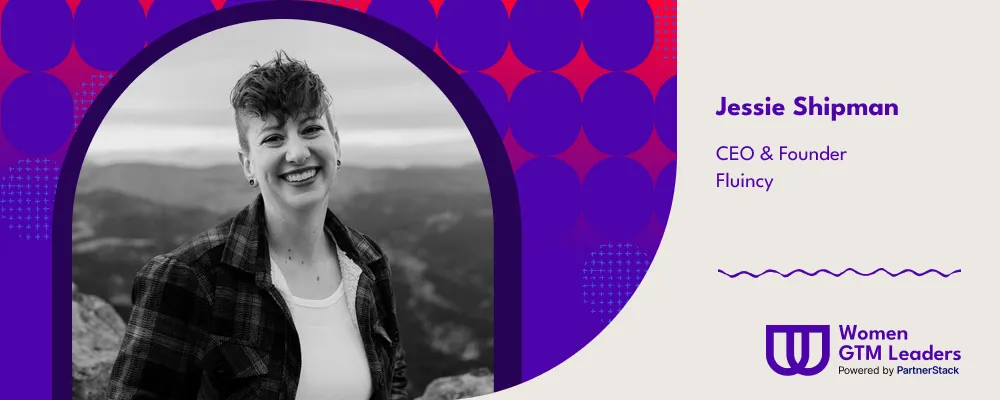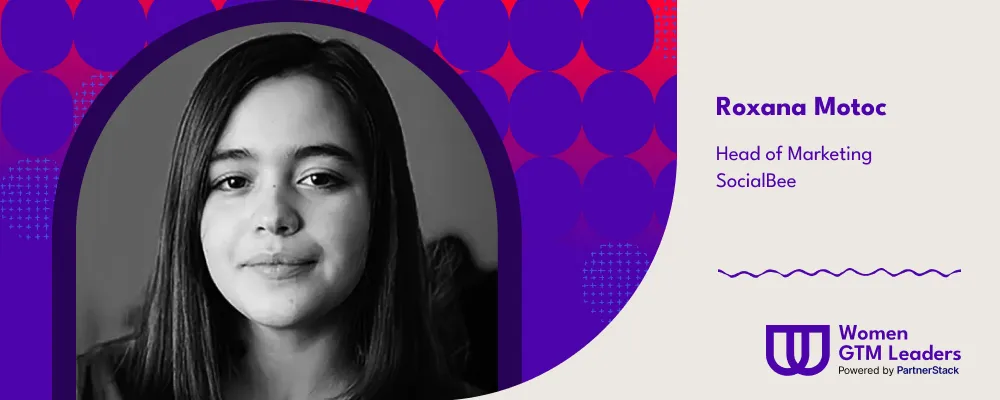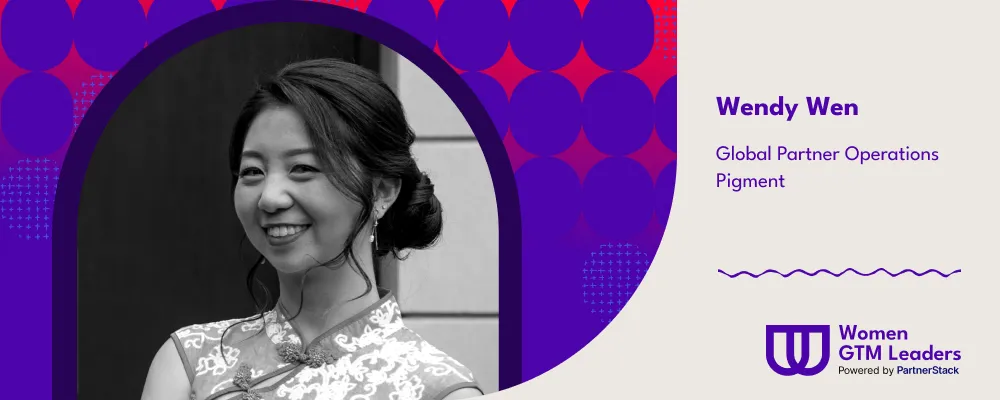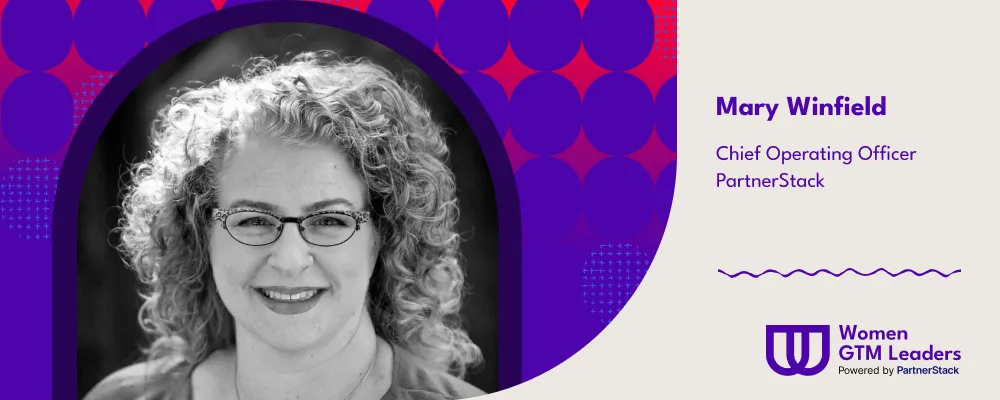It’s International Women’s Day 2024, and we’re feeling inspired. Today — and every other day — we get to share the partnerships space with incredible women leaders who have seen the B2B SaaS industry transform and who continue to drive change into the future. Who started in the Go-To-Market (GTM) environment thinking they could only get administrative roles and are now in the C suite. Who forged ahead with empathy without sacrificing results.
While gender roles in GTM may have shifted over these women’s careers, they haven’t changed much. Women make up just over 46% of the workforce, but hold 40.5% of management positions and only 29% of chief executive roles, according to research by Catalyst, a nonprofit focused on building better workplaces for women. When we look at the tech industry specifically, the numbers don’t get any better. According to figures from WomenTech Network, a global community for women in tech, just 5% of leadership roles in tech are held by women while nearly 70% of employees laid off amid industry turmoil in 2022 were women.
Tech can be tough for women not just in percentages, but on a personal level, too. Many of the women leaders we spoke to mentioned imposter syndrome and times when they weren’t treated fairly at work. But they also spoke with optimism, courage and plenty of wisdom for people — not just women — who want to lead in the GTM and partnerships spaces. Their focus on acting with empathy and recognizing the human on the other side of a partnership are takeaways for anyone looking to build a more equitable workplace.
That should be all of us, by the way— the Boston Consulting Group, writing in the Harvard Business Review, found that more diverse workplaces had more revenue from innovation and higher earnings. Meanwhile, research from consulting firm McKinsey found that a 10% increase in gender diversity in a workforce correlated with a 3.5% earnings increase.
More equitable workplaces just work better. That’s why we’re spreading the word. No matter what our gender, we can all inspire inclusion.
Featured GTM leaders
Related: Why authenticity in DEI practices in the workplace leads to good business.
Inspiring GTM Leader: Amy Scanlon, General Manager of Affiliate Practice, Right Side Up

Scanlon has more than 20 years of experience in digital marketing and has led growth initiatives for early-stage startups and well-established companies like Joyus, AT&T and Rakuten. Having started her career in affiliate marketing, she’s excited to see that “affiliate finally has a seat at the growth table.”
“Best-in-class affiliate programs fill gaps in your marketing mix,” she explains. “They align with your overall business goals, serve as a new customer acquisition tool, drive incremental revenue, and reduce your blended customer acquisition cost. Affiliates add value at every stage of the buyer journey and have not always received the recognition they deserve.”
Today, however, companies are starting to see the results of a commitment to affiliate marketing. “Buyers are perpetually connected, budget allocations are more complex and affiliates are endorsements for buying decisions,” Scanlon says. “Buyer patterns have changed to where a lot are starting on endorsement platforms like TikTok. They’re looking for social proofing — these third-party endorsement marketers.”
How women GTM leaders drive results differently than men
Rather than focusing on differences, Scanlon pushes for a people-first approach. “Most people doing affiliate work are women, whereas agencies are run by men,” she points out. “We have to have individuals motivated to rise. We need strategic thinkers and the right frameworks to bring a vision to life. We should be more focused on abundance growth than gender.”
Differences between women and men in leadership roles
Most leadership comes down to the individual, Scanlon says. There are, however, some common obstacles that most women leaders have faced. “The majority of women leaders have had to overcome similar challenges, like suffering from impostor syndrome,” she notes. “I believe in showing and demanding respect. My hope is that we see that we as women can help facilitate that by really knowing our value, asking for our value and putting ourselves in conversations where we express the value that we bring.”
Biggest lesson learned in 2023
Fortune favors the bold, Scanlon says. Despite a challenging economic environment and lots of uncertainty with the delayed pandemic, the biggest winners were customers who didn't pull back on their entire marketing budget and instead leaned in on the channels that were working.
The enabling model to do this is flexibility to deliver great services. At Right Side Up, we embed fractional resources into in-house teams for as many hours as needed and as long as needed, making it easier for companies to stand up and validate/invalidate channels without the risk of hiring an FTE or signing a 12-month agency agreement.
Best advice for women who aspire to be GTM leaders
Get the 30,000-foot view, Scanlon says. To do leadership work, she explains, it’s important to have broad experience, a wide operating range and alignment across teams. “Take a step back, gain experience where you can see the big picture and understand how that might fit into your GTM strategy,” Scanlon suggests.
In her own experience, connecting with other teams and broadening her knowledge made all the difference. “Befriending the product marketing and customer service teams made me successful,” Scanlon says. “Another thing was knowing the funnel. I was responsible for driving traffic to the funnel, but I had to know it inside-out.”
You might also like: Busting the most common myths about affiliate marketing.
Best advice for women in the partnership space
Stay in partnerships — and get in even deeper. “If you’re interested in partnerships, lean in,” Scanlon says. “Partnerships are going to be a force to be reckoned with. Reports show they’re leading to faster conversions.”
She also recommends keeping an open mind when it comes to potential relationships. “Be open to different partnerships. There might be alignment in places where you don’t think there is.”
If you had a magic wand and could change one thing in B2B
Justice for affiliates, Scanlon says. “The one thing I would change is the bias around affiliate marketing. There’s room for it as part of an ABM strategy. It can drive the next micro-conversion. It’s a large missed opportunity.”
Who’s inspiring you this International Women’s Day
Lissa Regets, Katie Kearsey, and Krystina Rubino, all at Right Side Up.
Inspiring GTM Leader: Jessie Shipman, Founder and CEO, Fluincy

It’s been a “strange, winding road” for Shipman, who went from teaching high school social studies to IT to sales before founding Fluincy. It hasn’t been easy to start a company in the wake of the pandemic; Shipman says there’s a “rigour around how people buy things [now] that makes it more challenging than in 2020 or 2021.”
Still, leaving the corporate world to start her own business was the right choice. “They’re looking for that perfect fit, where you’re smart, hard-working and able to solve the problem you’re hired for,” she says. “But I don’t want to be the cog you hired me to be. I don’t want to be this little thing in your machine. I want to be the computer that runs the machine. I saw myself with a seat at the table. And if no one is going to give me a seat — I’ll make my own table.”
Next on Shipman’s agenda is pulling up chairs for others. “I want to lead people,” she says. “I want to hire them for their worth and have an org where people can be their whole selves.”
How women GTM leaders drive results differently than men
Women can face a credibility gap — and this means thinking of ways to bridge it. “Women leaders have a tendency to think a bit more creatively,” Shipman says. “My experience is that there are barriers to trust. So getting to credibility requires a few extra steps for women than for men. I’ve had to take those extra steps my entire career.”
The good news is that credibility can be paid forward. “In my experience, a lot of my credibility is coming from referrals,” Shipman says. “If those referrals are coming from men trusted in the space, that trust gets translated to me.”
Differences between women and men in leadership roles
In Shipman’s experience, both women and men can be bad leaders. Many of her managers, she says, weren’t surprised that they ended up in a leadership position — which led to their feeling entitled to that role. “You mix in entitlement, a lack of empathy, insecurity, and what you end up with is a horrible leadership makeup,” Shipman explains. “Any time I’d be observant, any time I brought up that we should be thinking about something, it was taken as an affront, instead of, ‘let’s care about the work together.’”
By contrast, Shipman says, her best manager used an empathetic approach that made all the difference. “My top favourite manager was a woman. She wasn’t a manager who was a manager, she was a manager who was a leader,” Shipman recalls. “She would ask, ‘what’s on your mind?’ and ‘what’s your next step?’ That led me to think deeply about the work I was doing. There was an offer to connect, to do the work better together. Empathy and autonomy.”
This particular manager was also queer, which Shipman believes influenced her management style. “I think her life experiences made it so she had to be thoughtful on how she was going to lead,” Shipman says, “versus other managers who felt entitled to the position.”
Biggest lesson learned in 2023
“Which day?” Shipman jokes, before adding that her most important realization was that partnerships conversations were happening in an echo chamber. “As partner pros, all we’re doing is talking to each other,” she says. “So many partner leaders were having their feelings justified in these spaces. There is value in those conversations, but real change happens outside of an echo chamber.”
To move partnerships forward, she says, partner leaders need to start having conversations and offering value in spaces where CMOs and CROs are hanging out.
Best advice for women who aspire to be GTM leaders
“When you’re feeling uncertain, always ask yourself, ‘what would Chad do?’” Shipman recommends. “If you can put on that hat, you’ll almost always find that you’re better prepared and more qualified than you thought you were. Essentially, imagine you’d been told every day of your life that you are wonderful and capable and enough. Then act from that.”
Best advice for women in the partnership space
Shipman is adamant that most women already have the bona fides that successful partnerships require. “Your experience navigating the world as a woman — simultaneously holding all of the things you think about that are just simmering under the surface — makes you an ideal partner leader,” she says. “Having to think about your safety, the safety of others, the 80 million tasks you and your people are responsible for on the daily and keeping it all in order with empathy, grace and efficiency have equipped you to succeed in partnership. Own it. Conquer it.”
Who’s inspiring you this International Women’s Day
Sam Yarborough, Jen Spencer, and Cassandra Gholston.
Inspiring GTM Leader: Roxana Motoc, Head of Marketing, SocialBee

Motoc’s leadership journey began, she says, with her taking initiatives on projects that had to be done. “It was the perfect opportunity for me to gain more responsibility and experience while having guidance from mentors,” she says.
And with the GTM space using AI more and more, Motoc says she’s still taking the initiative to make marketing better. “The environment has seen a significant shift since my entry,” she explains. “Now, AI automates tasks like data analysis, customer segmentation and personalized marketing, leading to more efficient and targeted strategies.”
How women GTM leaders drive results differently than men
The biggest differences Motoc has noticed are in communication styles and approaches to problem solving — namely, that women tend to be more collaborative when making decisions and pushing for outcomes.
“Women in leadership are really good at effective conflict resolution and seeking input from diverse perspectives to inform the decision-making process,” she says. “While individual qualities outweigh any gender differences, I believe women bring a fresh approach to how we collaborate to drive results.”
See more: Women partnerships leaders give revenue-driving advice.
Biggest lesson learned in 2023
“People do business with people, so listening to and acting on any feedback we got from customers was key,” Motoc says, noting that this had to happen even as her team at SocialBee stayed resilient amid major market shifts.
Best advice for women who aspire to be GTM leaders
Curiosity and willingness to learn go a long way, Motoc says. She encourages women to look beyond job descriptions when evaluating roles. “Don’t be afraid to seek out guidance to define what your ideal job means and don’t be discouraged by the standard list of ‘if you’re in this position, you do or don’t do this,’” she says. “Roles evolve and so do you.”
Best advice for women in the partnership space
Find middle ground with partners from the very beginning, Motoc suggests, and it can change the entire collaboration for the better. Even if you can’t kick off with a sponsorship worth thousands of dollars, she says there are still creative ways to show partners you’re invested: buying them a subscription for a tool they need, giving them ready-to-use content or inviting them to events.
“Once the partner starts bringing results,” Motoc says, “you’ll have more freedom to increase their commission or send additional rewards to motivate them.”
Who’s inspiring you this International Women’s Day
Leila Cruz from ClickUp and Christy Oyedeji from AWeber.
Inspiring GTM Leader: Annie Tsai, COO, Interact

Along with her role at Interact, Tsai is a part-time partner with The House Fund, head of community engagement with Moms in Tech and columnist at San Mateo’s Daily Journal.
She’s been a tech executive since her 20s, when she was “in the right place at the right time and not intimidated to go into executive-level conversations” — all of which led to her becoming a director in the marketing organization of a public company at age 25.
“When you’re younger, you just don’t know what you don’t know,” Tsai says. “I had more imposter syndrome in my 30s than in my 20s — and that’s when I had to ask for help. A lot of early career advice is about how to find a mentor. But it’s not really about mentorship. It’s about proactively establishing relationships so you have champions: people who are thinking about you to do this work when you’re not in the room.”
Over the course of her years in tech, Tsai has seen trends come, go, and come back again under different names, but she’s always been a fan of partnerships. “What has happened over the decades, which I love, is the verticalization of this model,” she says. “There’s different ways to go to market now: down market, up market, very strategic partnerships.”
How women GTM leaders drive results differently than men
“I think about this a lot,” Tsai says. “For a long time, I didn’t think about it as a gender thing. I really saw it as a generational thing.” When she started out, 20 to 25 years ago, there was hardly ever another woman in the room, let alone an Asian woman. “One time, we were in the boardroom, laying out GTM investments,” she recalls. “The CFO disagreed with some of the investments, slammed his fist on the table and stomped out of the room. That doesn’t happen anymore.”
She adds that different generations have different ideas of fulfillment in their work and lives. “In the ’80s, you made money so you could have a life,” Tsai says. “Over the decades, it’s become far more integrated, this question of how you create a life where everything feels more balanced. As an employer and leader, these are things we have to think about when designing workforce and vision.”
As generations’ attitudes toward work have shifted, so have gender roles. Forty years ago, women in leadership roles existed in the workplace, but were less common. “Now you’re probably in the 85, 90 per cent range, especially in tech and in high cost-of-living areas,” Tsai says. “The demands on the income structure, the demands on the family structure and how that plays into the workplace — it’s very different.”
Differences between women and men in leadership roles
This comes down to generational differences, too, Tsai says. “All the managers I learned to be a manager from were boomers,” she notes. “Life was very transactional: we only focused on business and outcomes. We didn’t ask each other about our personal lives.”
Later, when millennials joined Tsai’s team, she had what she calls “an ‘aha’ moment.” “I would get this feedback that I was very mysterious, that I had a poker face, that they felt like they didn’t know me,” she recalls. “I never thought that was important in a leader before. But we model our leadership on who was around us.”
Tsai worked with an executive coach to evaluate her own leadership journey and discover which parts of her personality she’d suppressed to adopt the kind of leadership she’d seen modelled. By integrating the coach’s feedback and letting her own personality shine through, she says, she saw good results in her leadership style.
“We have to evolve company culture, especially in GTM,” she adds. “People care about the companies they work with now.”
Biggest lesson learned in 2023
Tsai had two takeaways: focus and beware of FOMO. Things are changing fast, she notes, so it’s more important than ever to learn to focus amid shifting markets and conditions. “There are macroeconomic events impacting your forecast, your GTM, big parts of your opportunity and strategy — and the velocity at which they happen is only increasing,” Tsai says. “It’s really easy, as a leader, to lose your focus.” Still, leaders can’t ignore what’s happening. So it’s critical to be able to incorporate new information and make sure the focus is on the right things.
In 2023, she also fought off FOMO. “It’s awful and real in tech right now,” Tsai says. “Especially if you’re venture-backed. We’re bootstrapped, so all day long, you’re seeing people close rounds of $300 million, and the FOMO problem feeds a lot of bad decisions.”
The key is to have a clear decision framework and stick to it, she says. “Don’t let FOMO feed the insecurity that you’re not doing enough.” At Interact, Tsai adds, there’s also a clear process for adding and dropping projects. In fact, the company has a percentage of bandwidth and budget allocated to testing ideas. Most of the ideas — Tsai says 60 to 70 per cent — don’t make it out of the testing phase. But that’s OK, because it means the company is sticking to a decision-making framework instead of chasing ideas that might not be worth it.
Best advice for women who aspire to be GTM leaders
Learn all the pieces of the business and take on projects beyond your scope, Tsai urges. “How your decisions impact other parts of the business, how the gears connect — if you don’t see this, you can’t be strategic,” she explains.
And the way to go beyond your scope is by building relationships, according to Tsai. “A lot of women in my life take great care in their relationships, and the quality of the relationships that you nurture over time is the most powerful tool in your toolbox,” she says. “How big of a closer you are matters, but it matters less than your network. Who you know, who you can call when you need an intro — that’s your biggest tool.”
Best advice for women in the partnership space
Again, Tsai emphasizes the importance of building relationships. “Your network is your most powerful tool,” she says. “People will remember the quality of your work, and it accrues over time. The longer you stay in tech, the more relationships you’re building. The more you give to your network, the more you’ll get back over time. That’s very powerful in a partnerships role.”
Who’s inspiring you this International Women’s Day
Tammy Aguillon, Maggie Chao, Jessica Gates, and Roopal Shah.
Inspiring GTM leader: Wendy Wen, Global Partner Operations Manager, Pigment

With a background in tech consulting and startup operations, Wen brings a proven track record of designing cross-functional solutions in the B2B space. She started in SaaS and consulting a decade ago, when, she says, buyers weren’t as informed when it came to ecosystems.
Over the years, she realized she likes partnerships more than consulting. “With consulting, you’re going project to project, jumping around, so it’s hard to see what you’ve done,” she says. “Whereas working in partnerships, you have a joint vision, making an impact with other tech companies and consulting firms.”
After the company where she worked was bought out and the pandemic happened, Wen decided to reevaluate. She joined Pigment in 2023 and says it’s in the “sweet spot” of a partner company married to a B2B Saas Series C company.
How women GTM leaders drive results differently than men
“Women tend to work more cross-functionally across departments. I know I do this — finding connections internally,” Wen says. “I start there and then look for external resources. Whereas men do the opposite. It’s not that men don’t look for advice. It’s that first they go to their counterparts at other companies.”
The lesson to be learned, she adds, is that there’s potentially a wealth of untapped knowledge inside the company. “If you’re the head of marketing in B2B and want to find comparables, talk to your head of sales and head of CS first,” Wen suggests.
Differences between women and men in leadership roles
Wen attributes different leadership styles to background and age more than gender. “I boil it down to the thought process: what did they major in, what kind of companies have they worked at, how do they approach problem solving,” she says. “I think that makes more of a difference than gender. And how we were raised before versus how leadership is now — we’re starting to see the full impact over generations.”
Biggest lesson learned in 2023
Last year was Wen’s introduction to l’art de vivre when she joined Pigment, which is headquartered in France. “I didn’t realize the difference in culture, but it makes an impact,” she says. “French culture is about making decisions through consensus, whereas the U.S. has a go-go-go mentality. At Pigment, we work more cross-functionally across different teams, and that way of working is making us healthier as a business.”
As a bonus, she adds, European vacation policies are more generous than American ones. “I feel like everyone is open to taking time off as they need,” Wen says. “It feels nice — they treat you like an adult.”
Best advice for women who aspire to be GTM leaders
Wen is all about being curious and unafraid to speak up. “Try to volunteer for new initiatives,” she suggests, “then listen and ask thoughtful questions along the way.”
Being assertive is also a great skill for women aiming for leadership roles. “Be proud of what you’ve done — don’t be afraid to take credit for your work,” Wen says. “And don’t be afraid to bring up problems. If you bring them to leadership, you’ll probably end up running point on that project. It’s always helpful to bring up issues when there’s a gap. The worst that can happen is they’ll say no.”
If you had a magic wand and could change one thing in B2B
B2B would take advantage of B2C marketing tactics if Wen had her way. “Individual consumers work in B2B,” she points out. “We don’t do a good job of brand recognition and brand image. But brand imaging sticks in the mind. B2C has nailed that, so we should copy it! We should think about doing advertisements and running events.”
Who’s inspiring you this International Women’s Day
Ashley Preston and Kari Pope.
Inspiring GTM leader: Mary Winfield, COO, PartnerStack

Previously VP of customer experience and trust at Lyft and VP of customer care at Intuit, Winfield joined PartnerStack as General Manager, Network in 2023 and became COO in early 2024.
Winfield’s career started after she moved from Texas to San Francisco in 1988. “My first job was living in San Francisco, and you gotta make money,” she recalls. “I went to Barnes and Noble, got a book on paradox programming, then took a train downtown and took a test. At the end of the week, I got a letter saying I had a role at GE as a paradox programmer.”
Soon she shifted from finance at GE to GTM, working on contract administration and sales support. “There were no women — no female salespeople,” Winfield says. “The best you could hope for was an administrator-type role.”
Since then, she’s watched the GTM ecosystem grow and moved between big-name companies. But she still makes time for cross-functional connections and says she’s proud to rank on PartnerStack’s leaderboard for Donut, a Slack add-on that introduces colleagues to one another. “The work that really matters right now is how do you find moments where you can get to know people as people, not just based on the work they deliver for your company,” she says.
How women GTM leaders drive results differently than men
“The piece that women in GTM have done,” Winfield says, “is they’ve made it OK to be empathetic and direct.” When she started in GTM, she recalls, being empathetic to clients wasn’t exactly top-of-mind for account reps. “It was about out-negotiating,” she says. “A sporting event: us against you, and I won this round.”
But as women have become GTM leaders over the past 10 to 15 years, the empathy piece has filtered into the field. “Women GTM sales leaders are as direct as any man I know. And it’s OK to be direct. But there’s an accelerator if you include empathy and customer concern,” Winfield says. “It’s about inquiry, not advocacy. Let me consult you versus let me sell to you.”
Differences between women and men in leadership roles
It’s less about gender and more about authenticity and passion, according to Winfield. “With more gender equity across GTM, for both men and women it’s expected that you’ll bring yourself into the equation,” she says. “It’s more about humans — GTM is just humans talking to other humans, trying to understand what they want and what they need. On a core level, you can’t stay in a space that you’re segmenting based on who the others in that space are.”
Best advice for women who aspire to be GTM leaders
Find a way to get out from under imposter syndrome. “Most women understand the concept of imposter syndrome,” Winfield says. “But you’re not an imposter. You have to find a way to trust yourself and what you know, and not discount your own thoughts and how you see things.”
Best advice for women in the partnership space
It’s okay for others to be uncomfortable. “What I see among women in partnerships is the tendency to kind of be the glue,” Winfield explains. “Speak your mind. Don’t hold back! Your job is not to make it comfortable for everybody. You should care how people feel and how they’re processing, but you can’t make it comfortable for everybody. Sometimes that discomfort will accelerate things faster than if you had made it okay for everyone.”
If you had a magic wand and could change one thing in B2B
Winfield would love for B2B to be more accessible. “I’d make it so it’s not so intimidating for folx,” she says. “When people talk to me about it, there’s some perception that it’s difficult and complex. It is different; it has such a structure around it compared to your consumer experience, which is so connected to your day-to-day life. But you’ve got to be able to explain B2B just like B2C.”
Who’s inspiring you this International Women’s Day
Kelli Dragovich, HR leader; and Kira Wampler, Board Member and Advisor, Lyft.

















